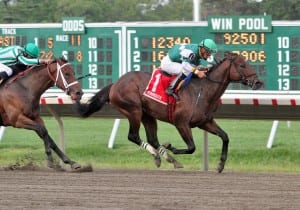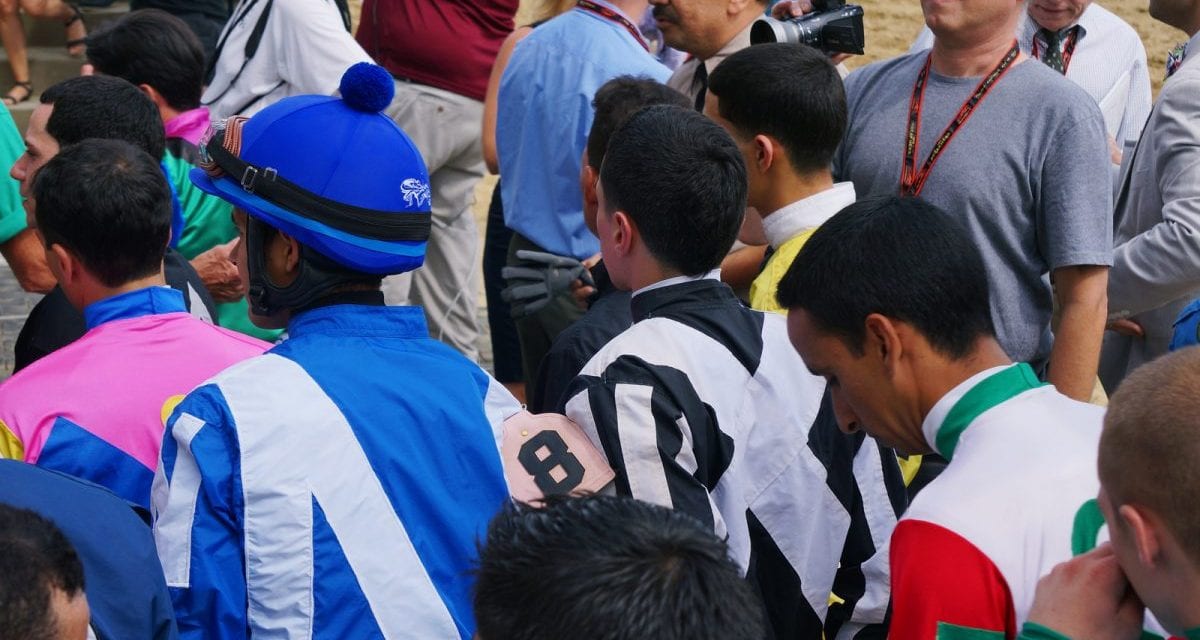In “Behind the numbers,” an occasional feature, we dig into racing data to see what’s really going on.

Paco Lopez, here taking the Grade 3 Jersey Shore aboard Prudhoe Bay, has more wins at Monmouth than any other rider has at a mid-Atlantic track. Photo By Ryan Denver/EQUI-PHOTO
Just five riders — of the 144 who have had at least one mount — account for more than 50 percent of all wins at Monmouth Park this season and have earned over 41 percent of all purse money.
It is the most dramatic, though hardly the only, evidence of how the jockey marketplace has become a “winner take all” market (that is, one characterized by a few players taking the vast majority of market share).
Indeed, the top five riders at each of the five major regional tracks currently operating — Delaware Park, Charles Town, Penn National, and Parx Racing, as well as Monmouth — have combined to account for 21 percent of all starts and roughly a third of all wins and purse earnings. There are on average 147 riders with at least one mount at each of these tracks, meaning that 3.4 percent of riders grab about a third of wins and earnings.
The trend is even clearer when one analyzes all riders by quintile (one-fifth). The top quintile overall at those tracks account for nearly 80 percent of all starts and roughly 85 percent of wins and purse earnings.
All of which doesn’t leave much for those toiling outside the top of their jockey colony.
Both Delaware and Monmouth — the two currently operating tracks that have defined seasons — have numbers that tilt rather significantly towards the top.
Monmouth’s numbers are significantly influenced by the presence of Paco Lopez; the jockey has won about 22 percent of all races contested at Monmouth and accounted for 16 percent of all purse earnings. As a result, Monmouth’s top quintile of just 28 jockeys accounts for 93 percent of all wins and 90 percent of all purse earnings at the track.
Meanwhile, the bottom three quintiles at Monmouth, comprising approximately 90 riders, has posted just two wins from 234 starts with purse earnings of less than $350,000.
At Delaware the story is similar. The top quintile at the Stanton track accounts for 75 percent of all starts and 86 percent of all wins and purse earnings. The top five jocks have won 38 percent of all races there and accrued 36 percent of all purse earnings.
As at Monmouth, the bottom three quintiles (77 riders) saw little action and less success: just 11 wins from 237 starts, with purse earnings of $332,500. Were those the statistics of a single rider, he or she would be tenth in the colony by purse earnings and tied for 11th in wins.
Perhaps not surprisingly, the top-bottom split is not quite so severe at those tracks that have year-round racing. That is likely because over the course of the year, riders are more likely to become injured, receive suspensions, or take time off than they are during a more compressed season. That gives a wider swath of the colony more opportunity.
Yet the topward tilt is still quite strong.
Indeed, the top quintile at the three year-round tracks have accounted for 78 percent of starts, 84 percent of wins, and 83 percent of purse earnings to date.
On the other hand, the top five bias is milder. The top five riders at those three tracks (by purse earnings) have accounted for about 23 percent of starts and 31 percent of wins and earnings. That means that about three percent of jockeys (15 out of 465) account for 31 percent of purse earnings at those tracks.
Remarkably, no rider in the region has won more at an individual track than has Lopez at Monmouth. That comes although the track has carded fewer than half as many races this year as have Charles Town, Parx, and Penn National, each of which has had more than 1,000. And Lopez’s nearly $2.9 million in purse earnings this season are a shade more than Frankie Pennington, who leads Parx riders, has generated.
The three riders who have done the most with the least — that is, earned the most money with the fewest wins — are Haskell winner Martin Garcia, whose $600,000 in purse earnings places him eighth on Monmouth’s list; Delaware Handicap winner Jose Ortiz (one win, $454,625 in earnings sixth); and Charles Town Classic winner Kent Desormeaux (one win, $1,000,000 in earnings, fifth).
And on the flip side? Five regional riders have made at least 20 starts at an individual track without posting a single victory: Jomar Ortega at Delaware (40 starts), Luis Garcia (21 starts) and Anthony Ortega (28) at Charles Town, David Castillo (40) at Parx, and Howard Lanci (36) at Penn National.
(Note: All data current as of August 19, 2014 and obtained from Equibase.)
(Featured photo by Vas.)








All of which goes to prove that the Jockey is 50% of the Handicap and not because that particular jockey has dominating skills, but the top jockeys get the top agents, who work with the top stables, who have the best horses,who will win the most races. The great equalizer is the looming threat of injury, the more mounts the more falls, and another spot opens up. No point waiting for a jockey to retire, they never make that decision on their own.